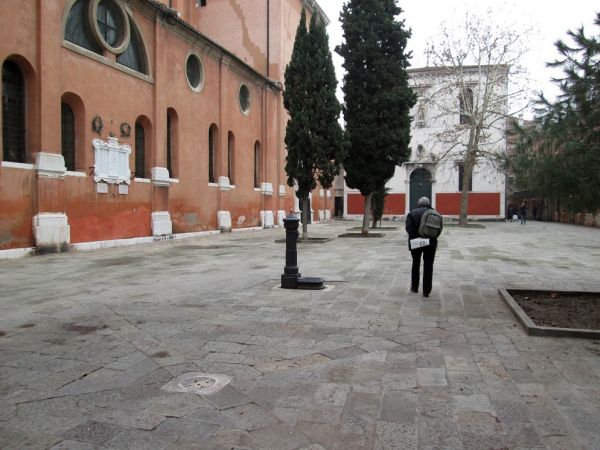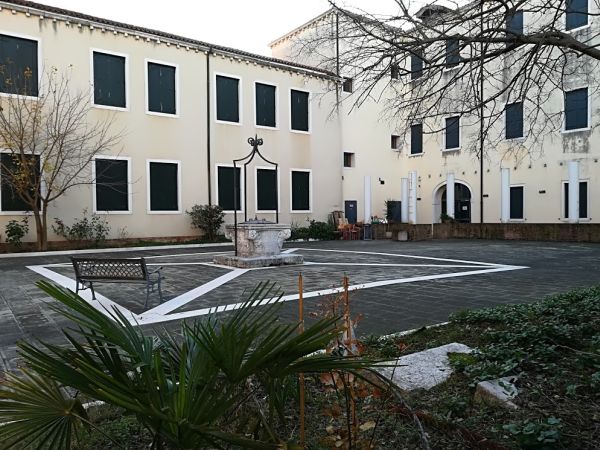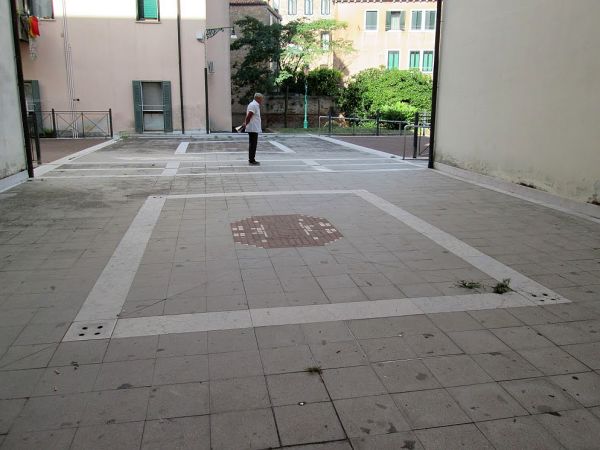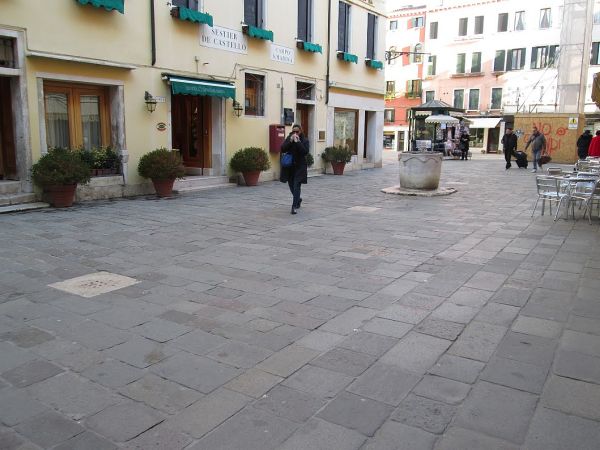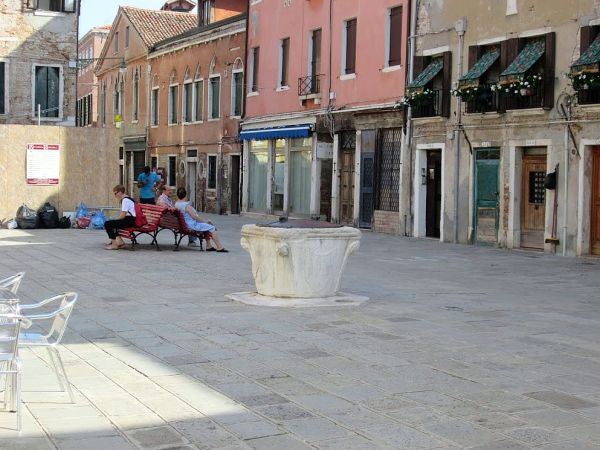I am hard at work on the next two chapters of the Venice Drinks Water! saga, but am going to be traveling for the next few weeks. I will attempt to write at least one post while I’m away, but if there is silence it’s only temporary.
Drink up — a few adjustments
Further reading on the subject of Venice’s rainwater cisterns has clarified a few points which I now want to correct (I will revise the earlier post accordingly).
There are conflicting accounts on the average depth of the well. One source says they never exceeded 16 feet (5 meters), others carry it downward to 21-40 feet (10-12 meters). I’m not qualified to referee this point.
One source says they would stop at the layer of caranto, another says they dug past it. Ditto.
As for the purpose of raising certain campi, one sharp-eyed reader asked me outright the question I had also wondered about (let that be a lesson to me to let sloth, even momentarily, get the upper hand). One source, which I referred to, says that it was to facilitate reaching the necessary depth. Another source makes more sense by stating that raising the surrounding area protected the well from the danger of being polluted by salt water in the case of an exceptional acqua alta. I mentioned accounts of wells being ruined by infiltration, so the campo, or part of a campo, with a well that was dug in an area known to be susceptible to high water (San Marco comes to mind) would have been raised.
Bonus information: Speaking of wells that have been ruined, of course the Venetians didn’t just sing a dirge, drape it with black and leave it there. They manned the pumps, as you see here:
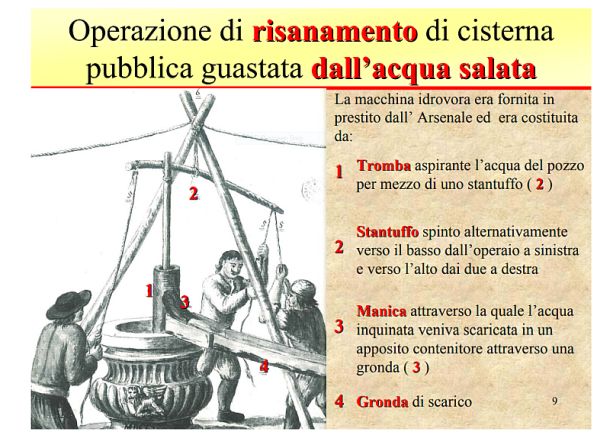
Drink up — more on the way
I have been surprised and glad to get such a lively reaction to my two latest posts about Venice’s wells, and drinking water in general.
More is on the way, including, I hope, some answers to a few interesting questions readers have raised. Meanwhile, there will be a brief pause while I dig deeper (sorry) and proceed with further scribbling.

Drink up: Rainwater cisterns
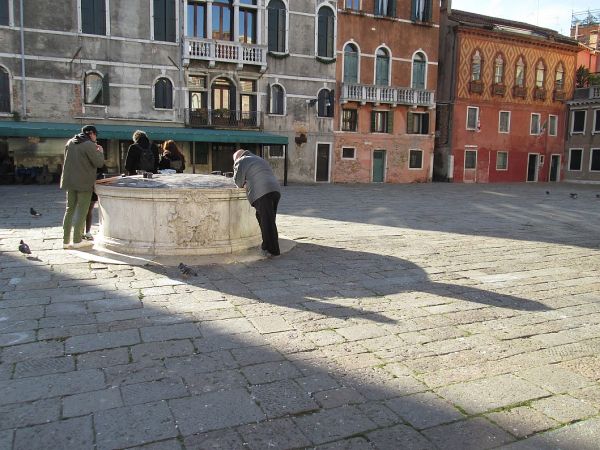
The recent break in the water main was only one of many episodes over the centuries which illustrate the particular difficulties facing a city condemned to live the life of the Ancient Mariner, surrounded by water but without any to drink. As historian Marin Sanudo famously put it in 1500 or so: “Venezia e’ in aqua ma non ha aqua” (Venice is in water but doesn’t have water). If you think it’s amazing to build a city where there’s almost no land, consider living in it without any water. You can’t drink wine all day. You certainly can’t wash your clothes in it. So if I say that Venetians built wells, it’s no less impressive than that they built palaces.
When the Venetian government moved from Malamocco to the Rialto area in the late 700’s A.D., it was clear that it made no sense to pay to bring water to Venice from the wells on the Lido. So the well-digging began, and by the time the Venetian Republic ended, there were thousands of wells in the city — some of them private, many of them public, and they remained the city’s only source of fresh water until the aqueduct from the mainland opened in 1884. That’s practically yesterday in Venetian years. There were telephones and color photography before there was running water in Venice.
The wells acquired water in one of three ways: Rainwater collected by means of an inclined pavement; water brought from mainland rivers and springs in waterboats operated by the acquaioli, or watermen, and, least common of all, artesian groundwater. All of them are closed now, the remaining wellheads a mere symbol of their former importance.
By the time the Venetian Republic fell there were some 6,000 wells in the city; today about 600 remain. That still seems like a lot, but an old Venetian wouldn’t be impressed. I picture a Venetian from 500 years ago visiting the city today and perhaps even before saying “What’s that light?” as the streetlamps are turned on, he or she would be saying “Where the hell are the wells? How do you people stay alive?”
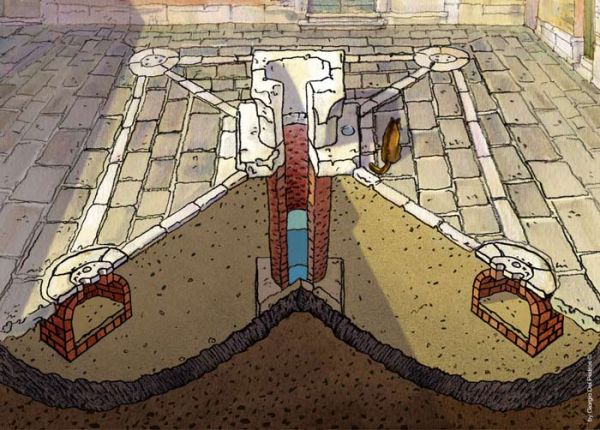
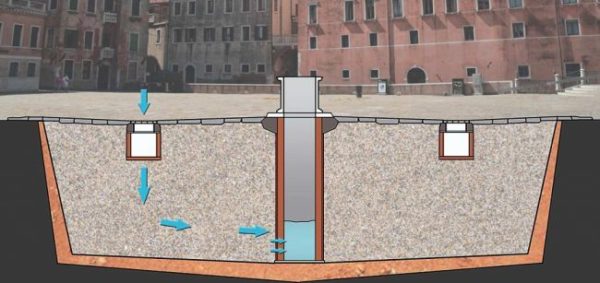
In 1300 there were about 100 wells in Venice. In 1322 the Great Council decreed the construction of another 50 wells. In the hope of continuing to create more the government generously subsidized well-building in the convents, on the condition that the water be available to everyone. There were also wells dedicated to the sole use of the poor, such as the one at San Marcuola.
In 1424 another 30 wells were realized. And so it went. In 1858 the Technical Office of Venice (still under the Austrian domination) estimated there were 6,046 private wells and 180 public, not counting the 556 which had already been filled in. Over the next century they were closed for good, and in many cases their wellheads were, to put it tactfully, removed.
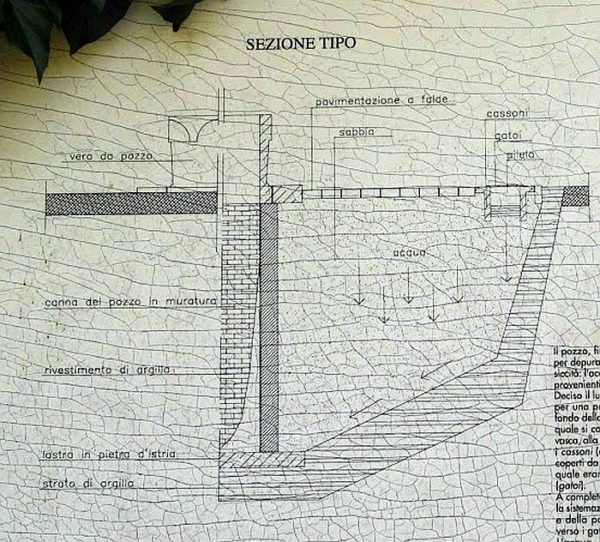
Constructing a well
The Venetian well is far from being a mere hole in the ground; it is a complex and carefully created structure, and the builders must have been demon geometers to figure out volumes and areas, not to mention calculating the tons of muddy soil to be removed.
The first thing to consider was the available area for what I call the platform, the inclined pavement which covered the entire opening of the pit and caused the rainwater to run into the “gatoli,” or drains, at each corner and ultimately into the cistern.
Whether the space was a square or a rectangle, squads of men known as pozzeri (well-builders) belonging to the bricklayers’ guild would dig a crater; one source says it never exceeded 16 feet (5 meters), another states that it could go down as far as 32-40 feet (10-12 meters). In any case, at the bottom the diggers hit the extremely hard clay substratum known as caranto. One source says they stopped there, another says they dug past it. I would gladly pursue this point further when I find the time.
To protect the well from possible pollution by salt water, some campi (or parts of them) were raised. A few typical examples are Campo San Trovaso, Sant’Angelo, and the Piazzetta dei Leoncini at San Marco.
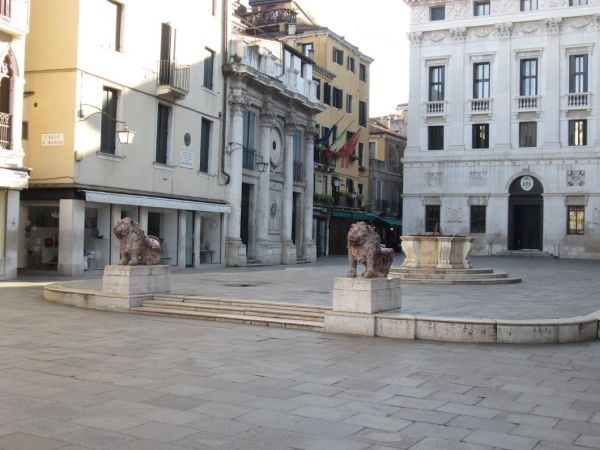
Once dug, the floor and sides of this cavity were lined with bricks, clay, or even caranto, to form a thick impermeable barrier. Then the pit was filled with layers of river sand of varying finenesses which filtered the rainwater running down into it..
The barrel of the well rested on a disk of Istrian marble, and was made of special bricks called pozzali which allowed the filtered water to enter the collection cistern.
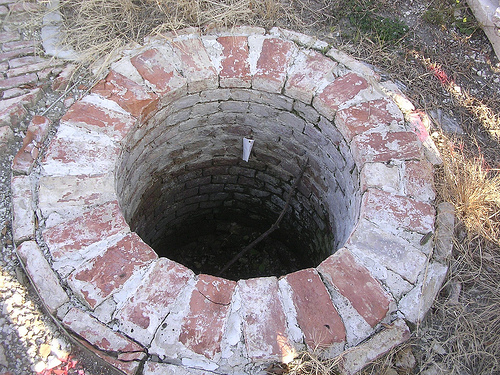
Finally the entire filled-in pit was covered with a layer of herringbone brickwork, upon which, in later years, the familiar stone paving blocks (masegni) were laid. Taken as a whole, this ingenious design not only kept the fresh water in, but kept out the brackish water surrounding it. People may complain about high water today because it’s a nuisance, but there were some acque alte in the distant past that were so high that documents chillingly report that “all the wells were ruined.” That prospect certainly puts a busted main in a different light.
All this work was expensive, of course, partly due to its complexity and partly from the sheer quantity of wet, messy, heavy material that was being moved around, and it had to be perfect. No weak spots, no miscalculated angles. Because of its value, the gift of a well to the city by a noble or wealthy family was considered an act of tremendous civic spirit, and of course made the donors look very good indeed. The government obviously encouraged these gifts, and permitted the generous family’s name to be incised on the wellhead. Venetians generally weren’t allowed to indulge much in “Look at me, look at me,” but a few encomiums could be allowed for giving a public well.
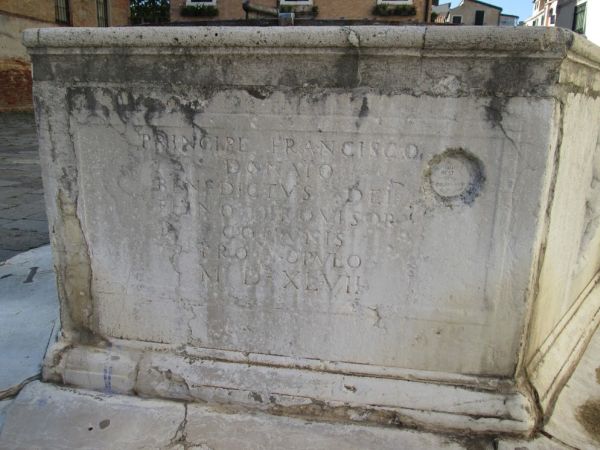
Using the wells
Commercial enterprises — especially those, such as cloth dying, that needed large amounts of water — were forbidden to use the public wells. They had to buy it from the waterboats, otherwise there’d obviously be nothing left for anyone else.
The regular people could draw water when they needed it, but only in the daytime. At night the wells were closed by heavy covers, usually of iron but sometimes of wood, and locked until the campana dei pozzi (bell of the wells) rang in the morning when they were opened, and again in the evening when they were covered again. The keys to the well-cover were kept by a specifically authorized person, either the district warden or, more commonly, the parish priest. Rainwater is called acqua piovana (pyo-VAH-na), and so eventually the priest was nicknamed the piovan. Keeper of the rainwater. I think that would look excellent on somebody’s resume.
Along with discouraging theft, locking the wells should have deterred suicides, but occasionally a desperate person — despite being surrounded by canals conveniently full of water — would put an end to it all by throwing him- or herself into one. This seems to me to be an unusually harsh way to drown, not to mention rude and thoughtless considering that you thereby ruined countless gallons of precious H2O for God knows how many months for an entire neighborhood. I can’t imagine your average Venetian would feel much sympathy for the victim when the day’s bucket was empty.
